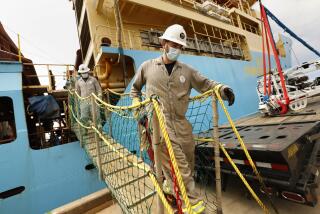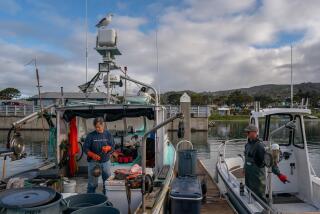Abalone Aquaculture Comes Out of Its Shell on Central Coast
- Share via
Aquaculture’s strides toward becoming a reliable source of scarce seafood species are evident from a Central California shellfish operation’s recent announcement.
Last week, the Abalone Farm Inc., of Point Estero, harvested its one-millionth commercial-sized abalone. The milestone is significant because the mollusks have proved difficult to cultivate, and, as a result, there are less than half-a-dozen such operations currently in existence.
The firm began growing the prized shellfish in cement tanks on a bluff overlooking Morro Bay in 1981. Initially, the Abalone Farm counted only one restaurant as a customer.
But in subsequent years, the facility expanded and now distributes into five states and exports to Japan.
The abalone, which sell for $2.50 each or about $30 a pound, are harvested when they reach only several inches in size.
One of the company’s first marketing obstacles was to persuade chefs to accept the farm-raised variety, which is noticeably smaller than the plate-size, wild abalone that are caught by scuba divers in the Pacific Ocean.
This year the Abalone Farm expects to market 50 metric tons of the shellfish or about 600,000 of the mollusks. The production is expected to double annually through 1993. The firm also sells abalone seeds to other aquaculture ventures.
Developing the facility and related activities have proved difficult, according to a company representative.
“The process of getting to the (one-millionth) abalone has been as slow as an abalone’s pace,” the firm stated.
Change of Rank--The seafood industry’s recently launched advertising campaign had to make a last-minute switch in the name of its cartoon mascot at the request of the federal government.
The promotion, whose theme is “Eat Fish and Shellfish Twice a Week,” originally set out to call its officious, mustachioed “spokesfish” the “Sturgeon General.”
However, the U.S. Department of Health and Human Services asked that the name be shelved because it was disrespectful of the agency’s real-life surgeon general. There was also the possibility that the public might confuse the commercial’s recommendation about seafood consumption with health and dietary guidelines issued by the most recent occupant of the surgeon general’s office, C. Everett Koop.
“They thought it was denigrating to the surgeon general’s office,” said Paul Ahrens, assistant account executive for W.B. Doner & Co., the Baltimore-based agency that developed the campaign. “They also said that it took away from the seriousness of the office and that making fun of the surgeon general was not in good taste.”
The agency, which designed the $6.5 million campaign for the National Fish and Seafood Promotional Council, solved the problem by simply renaming its cartoon character “America’s Official Spokesfish.”
Although the campaign’s main thrust will come in October, National Seafood Month, the television commercials for seafood have already been airing.
“Things are going well, so far was we can tell,” said Ahrens.
The agency is also conducting research to measure attitudes about seafood both before and after the promotion, he said.
Regulating Bones--A federal proposal would increase the number of bones present in fish fillets, according to a Washington-based newsletter.
The National Marine Fisheries Service is in the final stages of adopting a regulation that would allow seafood processors to sell fish with bones still remaining in the flesh as long as the product was labeled as such, Nutrition Week reports. The measure is considered a labor-saving device and one that may lower the price of certain seafood varieties.
The plan would encompass all species and the presence of cartilage would no longer be considered a “workmanship defect,” according to the federal announcement.
The regulation was originally requested by food retailers and the seafood industry. The proposal was then formulated by the fisheries service in 1985 when the agency asked for public comment on the idea.
Many of the comments received were positive, although the U.S. Food and Drug Administration said that most consumers believe that the term fillet indicates boneless fish, the newsletter stated. FDA officials urged that labeling clearly indicate the presence of bones.
Comments are being accepted on a final version of the regulation until Sept. 6. Once the regulation is approved, the products will be sold as “semi-boneless fillet-style” or as “bone-in fillets.”
The size of the bones allowed by the agency will depend upon the species involved, said Thomas J. Moreau, technical services unit director, with the National Marine Fisheries Service in Gloucester, MA.
The fisheries service conducts a voluntary seafood inspection program for the U.S. Commerce Department. Prior to the current regulation, any fillets containing bones would not qualify for the U.S. Grade A designation.
“The regulation will allow (bone-in) product to be processed under federal inspection and be eligibile to be graded,” said Moreau. “If it does, in fact, contain bones then it will have to be labeled properly, but it can also then carry the U.S. Grade A stamp and the U.S. Department of Commerce Inspection mark.”
Moreau said that the size of the fish bones will vary but that the cartilage can be easily removed by consumers.
More to Read
Inside the business of entertainment
The Wide Shot brings you news, analysis and insights on everything from streaming wars to production — and what it all means for the future.
You may occasionally receive promotional content from the Los Angeles Times.










